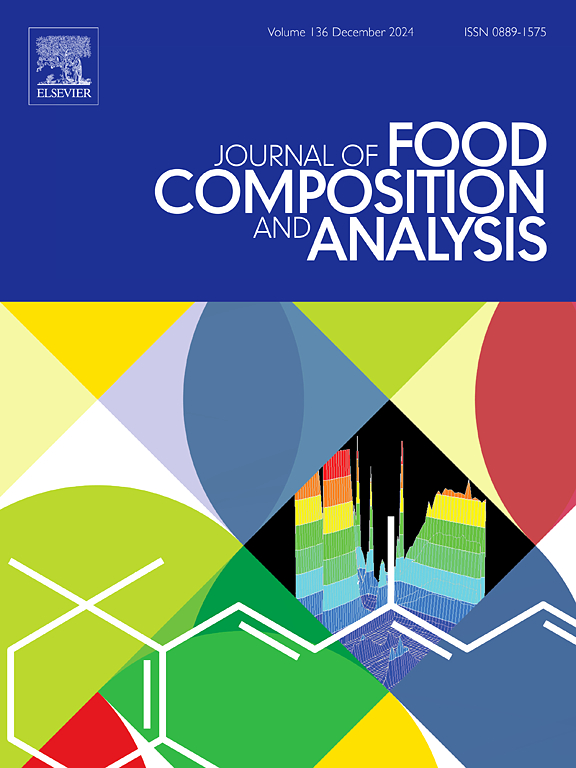Fluoride in beer by direct potentiometry and ion-specific electrode: Method assessment, validation, and application to commercial samples
IF 4.6
2区 农林科学
Q2 CHEMISTRY, APPLIED
引用次数: 0
Abstract
At present, beer is produced from the alcoholic fermentation of wort prepared with malt, barley or wheat and water, flavoured with hops. The main raw materials for producing beer are: water, barley, hops, yeasts. Unlike other alcoholic or distilled beverages, water is added during the preparation of the must. Consequently, in the mineral content of beer, the composition of the water is of great importance. Among the trace elements, fluoride, can be a common ion in water. This study describes and validates a potentiometric method, using an ion-selective electrode, to measure fluoride concentrations in the beer samples without preliminary treatments. The obtained detection limit (LOD) is 0.0006 mg L−1 while quantification limit (LOQ) is 0.0017 mg L−1. The standard addition method, used in this research, allows to obtain straight lines whose r2 is higher 0.999. The sensitivity is very close to the theoretical one (59.16 mV at 25°C), in fact the electric potential varies by 55 ± 3 mV when the concentration differs by one order of magnitude. In an unusually low concentration interval 0.045 – 0.45 mg L−1 acceptable precision and recoveries (<95 %) were obtained. The method was applied to 28 beer samples consumed in Sicilia (Italy) most of which were produced in other European countries having different alcoholic content. Fluoride concentration in the analysed samples was in the range 0.17–0.32 mg L−1. The statistical treatment indicates a strong positive relationship between fluoride concentration and beer origin, indicating that this is closely related to the fluoride concentration. Conversely, alcohol content and beer type show a negative correlation with fluoride concentration. Considering all the analysed samples, the maximum value of the contribution to the diet corresponds to 3 %, obtained consuming 0.66 L of a lager beer produced in Italy.
通过直接电位法和离子特异性电极测定啤酒中的氟化物:方法评估、验证和商业样品的应用
目前,啤酒是由麦芽、大麦或小麦和水制成的麦芽汁酒精发酵而成,并加入啤酒花调味。生产啤酒的主要原料有:水、大麦、啤酒花、酵母。与其他酒精或蒸馏饮料不同,在制作过程中要加水。因此,在啤酒的矿物质含量中,水的组成是非常重要的。在微量元素中,氟化物是水中常见的离子。本研究描述并验证了一种电位法,使用离子选择电极,测量啤酒样品中的氟化物浓度,而无需进行初步处理。检测限(LOD)为0.0006 mg L−1,定量限(LOQ)为0.0017 mg L−1。本研究采用标准加法法,可以得到r2大于0.999的直线。灵敏度非常接近理论值(25°C时59.16 mV),当浓度相差一个数量级时,电势变化为55 ± 3 mV。在异常低的浓度区间0.045 - 0.45 mg L−1,获得了可接受的精密度和回收率(<95 %)。该方法应用于西西里(意大利)消费的28个啤酒样品,其中大多数是在其他欧洲国家生产的,具有不同的酒精含量。分析样品中的氟化物浓度范围为0.17-0.32 mg L−1。经统计处理,氟化物浓度与啤酒产地呈正相关,表明产地与氟化物浓度密切相关。相反,酒精含量和啤酒类型与氟浓度呈负相关。考虑到所有分析样本,对饮食贡献的最大值对应于3 %,消耗0.66 L意大利生产的啤酒。
本文章由计算机程序翻译,如有差异,请以英文原文为准。
求助全文
约1分钟内获得全文
求助全文
来源期刊

Journal of Food Composition and Analysis
工程技术-食品科技
CiteScore
6.20
自引率
11.60%
发文量
601
审稿时长
53 days
期刊介绍:
The Journal of Food Composition and Analysis publishes manuscripts on scientific aspects of data on the chemical composition of human foods, with particular emphasis on actual data on composition of foods; analytical methods; studies on the manipulation, storage, distribution and use of food composition data; and studies on the statistics, use and distribution of such data and data systems. The Journal''s basis is nutrient composition, with increasing emphasis on bioactive non-nutrient and anti-nutrient components. Papers must provide sufficient description of the food samples, analytical methods, quality control procedures and statistical treatments of the data to permit the end users of the food composition data to evaluate the appropriateness of such data in their projects.
The Journal does not publish papers on: microbiological compounds; sensory quality; aromatics/volatiles in food and wine; essential oils; organoleptic characteristics of food; physical properties; or clinical papers and pharmacology-related papers.
 求助内容:
求助内容: 应助结果提醒方式:
应助结果提醒方式:


